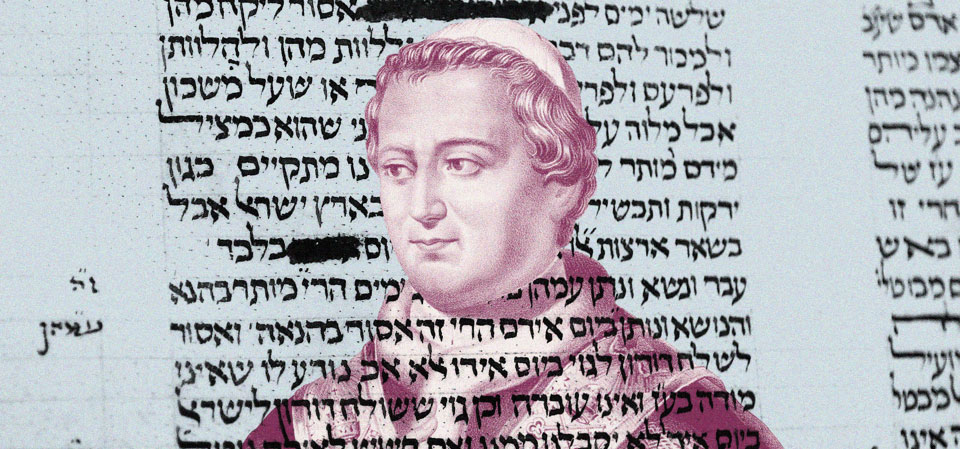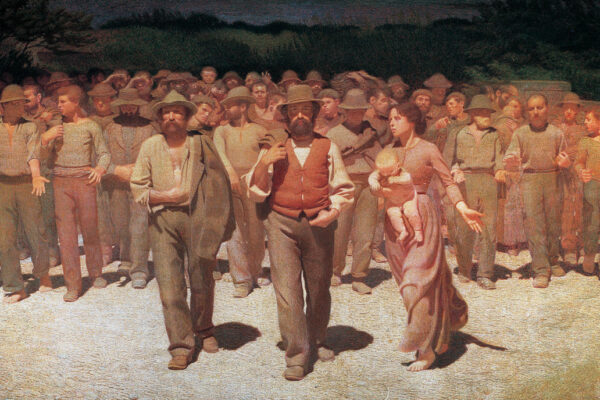The Doctored ‘Memoir’ of a Jewish Boy Kidnapped by the Vatican
The case has reverberated into the 21st century. Pope John Paul II’s decision to beatify Pius IX in 2000 led to angry protests from the descendants of the Mortara family and from Rome’s Jewish community.More recently, Steven Spielberg’s announcement that he plans to make a movie about the event (based on my book, The Kidnapping of Edgardo Mortara) produced a new burst of attention, especially from conservatives in the Roman Catholic Church worried about popular reaction to the retelling of the story. Perhaps most unexpectedly, the Mortara affair has been taken up as a cudgel in the internal Church struggles over Pope Francis’s attempts to reform the Church.
Edgardo Mortara’s own account of these events recently appeared in English for the first time. But if anyone was expecting it to help clarify the controversial event at the heart of the story, they were deeply mistaken. Indeed, a reviewer for the conservative Catholic journal First Things used the text to defend Pius IX’s actions, sparking numerousheatedresponses, including from an archbishop. What none of them has addressed, however, is that the published memoir itself has been heavily doctored.
The actual document Edgardo wrote differs in many passages from what Vittorio Messori, Italy’s foremost conservative Catholic journalist-turned-polemicist, has published.
Messori’s work represents the first translation of Edgardo’s memoir—originally written in Spanish—first into Italian, then into English. And it’s a work that casts the episode in a light sympathetic to Pius IX.The Atlantic emailed Messori, one of the most influential critics of Pope Francis in Italy, asking him to explain the discrepancies. Messori at first attributed any errors to the English translation of his book, which he said he did not get to review.
But the same discrepancies appear in the Italian version he prepared himself; asked to comment on specific passages, he did not respond.In 1888, three decades after he was taken from his family, Edgardo wrote an account of his story in Spanish, referring to himself in the third person. By then, having been raised in a seminary, he had become a Catholic priest; years later, members of his order prepared a typescript of his account. It was the copy of this spiral-bound memoir in Rome’s Canons Regular archive that Messori says he found and translated into Italian for publication; the English version that appeared last fall relies on Messori’s translation, rather than the original Spanish.I personally compared the Italian and English versions of the Edgardo Mortara memoir published by Messori with the original, which I too located at the Canons Regular archive and digitized.
In Messori’s version of the memoir, the reader is treated to a heartwarming story of a six-year-old child who is overjoyed to be taken from his parents so that he can become a Catholic—a child who would later have an uncannily accurate memory of what had happened to him.
But this is not the narrative Edgardo actually wrote. The happy version instead emerges from numerous changes to the original, including the addition and deletion of entire paragraphs—changes that are common to both published versions of the Edgardo Mortara memoir in Italian and English.
A case in point is the addition of a 300-word paragraph, presented seamlessly with the rest of the text. It offers a justification for Pius IX’s action in ordering Edgardo’s removal from his family, and also describes the touching scene of the Inquisitor, Father Feletti, the man responsible for ordering the boy taken, going to see little Edgardo.“In Rome, with great pleasure and tears in his eyes,” Messori’s version of the memoir reads, “Father Feletti hugged the Mortara child, for whose eternal salvation he had suffered so much, and he always had a special affection for him. Father Mortara will always hold very dear the memory of this respectable friar, who was one of those who more closely intervened in the spiritual regeneration and rehabilitation of his soul.” Neither this scene, nor the rest of the paragraph in which it appears, are to be found in Edgardo’s original memoir.
Many of Messori’s deletions involve omitting observations by Edgardo that fit uneasily with a pro-Church narrative. Edgardo, for example, notes in his original account that the servant who baptized him was only 16 years old. This is an important point, since his parents had used the fact that she was both illiterate and young to try to discredit her account of the baptism. But Messori’s version does not include this detail.
Similarly, in the original memoir, Edgardo writes of the pope’s decision to send the police to seize him: “Given that they [the Mortara parents] did not consent, Pius IX had to proceed, as Pope and as King, to the order of violent kidnapping.” Messori’s version does not include the terms “violent” or “kidnapping,” so that the pope’s “order of violent kidnapping” becomes simply an “order of sequestration.”Defenders of the pope’s action in taking Edgardo have argued that the events had nothing to do with anti-Semitism, yet the way Church authorities treated Jews was deeply rooted in demonization.
It is telling that some of the alterations Messori’s version makes to Edgardo’s actual words come at those points of his memoir where Edgardo reveals the anti-Semitic attitudes his Church mentors had drummed into him. Edgardo recalls his embarrassment as a child when, together with his fellow seminary students in Rome, he “walked through the ghetto, or Jewish district.” Messori’s version of the memoir ends the sentence there, but Edgardo’s original continues that he had “always professed an inexpressible horror” toward the Jews. Similarly, later in his account, in referring to his parents, Edgardo writes, “The Mortaras hold to the Jewish religion, which is false, contradictory, absurd, condemned by history, and condemned to be labeled ‘ridiculous,’ as it is by most men.” Messori’s version does not include the “false,” the “absurd,” the “ridiculous,” and the condemnation—a softening of language that lessens the impression that Church mentors may have filled a Jewish child’s mind with anti-Semitic ideas.
But the problems with the accuracy of the memoir are not limited to distortions in Messori’s translation. The man who wrote this account had been separated from his family at age six, suffered from numerous psychological ills later in life, and was constantly bombarded with the official Church narrative of the divine grace he had received. By the time he wrote his recollections, he had incorporated that Church narrative into sermons he was delivering throughout Europe, praising Pius IX for having him taken from his parents. In this way, he was able to justify his own choice to become a priest while inspiring his listeners to embrace Jesus and the Church.
The part of the memoir that the conservative Catholic media is most loudly trumpeting today is Edgardo’s description of how, after learning of the baptism but before Edgardo was taken away, Pius IX repeatedly tried to arrange some kind of compromise with his parents. In Edgardo’s original account, the pope proposed sending him to a Catholic boarding school in Bologna, for, “That way, his parents would be able to visit him whenever they wanted.”
The Inquisitor, Edgardo writes, repeatedly went to the Mortara home to convince his parents to accept the pope’s thoughtful plan. Ignatius Press, publisher of the English-language memoir, highlights this episode in its brief catalogue blurb for the book, and in his introduction Messori calls this the book’s greatest “revelation.”
Yet this account is pure invention—and not by Messori, but by Edgardo himself. The Inquisitor went on trial in 1860 on charges of kidnapping the boy; trial transcripts offering hundreds of pages of first-hand accounts—from the boy’s parents, the police, and the Inquisitor—all make clear that the Inquisitor never spoke with the Mortaras before the papal police took Edgardo away. The appearance of the police that night in June 1858 came as a complete shock to the Mortaras. The only offer that Church authorities ever made came after the boy was already securely in Rome in the House of the Catechumens, the Church institution dedicated to converting the Jews.
Edgardo’s parents were then told that if they themselves were to enter the House of Catechumens along with the rest of their children, and accept baptism, they would once again be able to live together as a family—a Christian family.As if to ward off questions about the accuracy of Edgardo’s memory, Messori makes repeated corrections throughout the text to verifiable historical mistakes, including names of Church officials and locations and dates of certain events, without noting that he is making changes.
Messori, though, is hardly the first to alter Edgardo’s story; rather, his book piles a new generation of inventions upon the old. Church defenders have long crafted their own narrative of what happened to the boy and his parents, instrumentalizing the Mortara family tragedy to tell a story that suited their purposes.
After the boy’s kidnapping, as accounts spread of his mother’s loud wailing, his father’s fainting, and his siblings’ terror, Church partisans began spreading their own, very different narrative of what had happened. In the fall of 1858, Bologna’s Catholic newspaper reported that the child’s removal “was all carried out with gentleness, solely through the use of persuasion” and that “whenever the carriage stopped in any town or city [on its way to Rome], the first thing that he asked was to be taken to the church, and when he entered he remained there at length, showing the … most moving devotion.” No account was more influential than that published around the same time in the Vatican-supervised Jesuit journal, Civiltà Cattolica.
It claimed that Edgardo showed “extraordinary happiness” on entering the Catechumens. The boy, the Jesuit journal reported, had a single idea “stamped on his forehead, and even more in his heart … the singular grace that he had received through Baptism and, by contrast, the immense misfortune for his parents of being and wanting to remain Jews.”Today, the Edgardo Mortara episode continues to roil the Roman Catholic Church and Catholic-Jewish relations.
For those in the Church unhappy with the relatively progressive path the current pontiff is set upon, Pius IX remains a hero, the model of a pope who would risk all to stand up for the eternal verities of the faith. Those who take a different view should know that the translation of Edgardo’s memoir is not a faithful one. Edgardo did indeed praise Pius IX, but the story of what actually happened to him as a child is different from what that pope’s supporters would have us believe.









